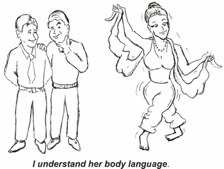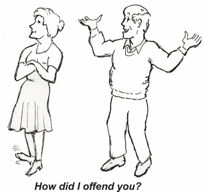Sort Articles:
Communications
Written by: Ralph Twombly
Published: Thu Mar 25 2021 17:25:19 GMT-0400 (Eastern Daylight Time)

“When Aeschines spoke, they said, ‘How well he speaks.’ But when Demosthenes spoke, they said, ‘Let us march…”
~Famous Greek Quote
Let’s be clear here about communication methods for leaders. Face-to-face communication is best. Not just best, it is best by a mile. A phone conversation is next best, but it is no substitute for face-to-face connection. You may ask, “Is FaceTime technology as good as face-to-face time?” Forgive me because I’m not fond of the word “no”, but no. It is better than an email, a text, or a hand-written note, but it is not the same as face-to-face.
 Conversations that are face-to-face are better than any other communication. There is something about being with others that cannot be replicated in a two-dimensional image, electronic message, or even a phone call. If you can see another person’s face and experience their presence, you are able to feel a connection with that person. It is understood that we would all love our communications to be more efficient and effective. Making a connection through direct, engaged communication is powerful and keeps the flow of conversations moving.
Conversations that are face-to-face are better than any other communication. There is something about being with others that cannot be replicated in a two-dimensional image, electronic message, or even a phone call. If you can see another person’s face and experience their presence, you are able to feel a connection with that person. It is understood that we would all love our communications to be more efficient and effective. Making a connection through direct, engaged communication is powerful and keeps the flow of conversations moving.
Almost every organization that I have ever worked with claims to have a communication issue. After a little bit of research, it seems that there are several issues around the theme of communication including lack of trust, differing objectives, impatience, lack of tolerance for other points of view, or a lack of effort on the part of the communicators. Sometimes it feels like we are trying to speak different languages. In the over forty years that I have been in the business world, we have progressed from writing memos, which only transmit a two-dimensional communication, to writing emails, texts, chat, FaceTime, and I’m sure I’m missing many more. The question is, how much “real” communication happens once face-to-face contact is removed from the equation? Here is what the experts at study.com say:
There are four methods of communications - interpersonal communication, nonverbal communication, written communication, and oral communication
There are five types of communications - 1) Verbal Communication, 2) Non-verbal / Interpersonal Communication, 3) Written Communication, 4) Formal & Informal, 5) Visual Communication.
 And because that isn’t enough - Body language is widely viewed as having the lion’s share of communication and there is evidence that backs this up. After body language, the next highest level of communication is experienced through voice tone and finally, communication is shared through our words. Words spoken carry inflection but without that, my sense is that the 7% shown in the graph here might be a little high.
And because that isn’t enough - Body language is widely viewed as having the lion’s share of communication and there is evidence that backs this up. After body language, the next highest level of communication is experienced through voice tone and finally, communication is shared through our words. Words spoken carry inflection but without that, my sense is that the 7% shown in the graph here might be a little high.
So, even if you are going to use methods and types galore, your body language will always tip off your true feelings and intent.
Keeping it correct or jeez, can we say anything? Maybe it is important to place this whole section under the umbrella of the times in which we live. It is difficult enough to say what we want, and have it understood, without all the extreme correctness to keep in mind as we consider our words. The #Metoo movement has a language, and relationships between people with different colored skin has its language parameters, too. Add in the lives people choose in terms of sexual preference, religion, and political parties, and no wonder we are always worried if we are using the appropriate words to keep from offending others.
My guess is that times things have not changed considerably from the times before technology ruled the earth, nor has the difficulty we feel in our ability to speak with one another. Many of us were here before the advent of computers and smart phones. We weren’t any better at non-offensive communication then than we are today. In fact, I’ll bet I may have just offended someone, somehow with this paragraph.
 The good news, based on statistics, is that between 70% to 75% of our workday still involves speaking and listening. In fact, problems occur when people don’t gain proximity to each other when they communicate. Okay, are you getting discouraged yet? Don’t worry, it is possible to make sense of the challenges and improve your communication skills.
The good news, based on statistics, is that between 70% to 75% of our workday still involves speaking and listening. In fact, problems occur when people don’t gain proximity to each other when they communicate. Okay, are you getting discouraged yet? Don’t worry, it is possible to make sense of the challenges and improve your communication skills.
Let’s break it down by what constitutes good communication.
- When the message is delivered in the method that will give the greatest result.
- When the message is appropriate for the situation, meaning, not too much or too little.
- When the person being communicated with feels something that they didn’t feel before the interaction.
- When the person being communicated with truly understands the content and the intent of the message and messenger.
Communications That Builds your Career – and Life
“One ought, every day, at least, to hear a little song, read a good poem, see a fine picture, and, if it were possible, to speak a few reasonable words.”
Johann Wolfgang von Goethe
Now let’s talk about things that can build your career and make your life easier.
Communication is our privilege not our responsibility - Probably the greatest gift we were all given, aside from a big brain, is our ability to communicate. I’m pretty sure our house pets and animals ‘in the wild’ communicate, but I’m betting that their communication methods have a lot to do with why we are the dominant species. Of course, if you have ever owned a pair of black cats like I have, you might start to doubt that whole human dominance claim.

 Simple things like our knowledge, our health and even our families are fed by our ability or inability to listen and comprehend. I can’t remember ever hearing anyone say that their mom’s money, or wardrobe, or minivan changed their lives. What I hear is usually something like, “My mom’s pearls of wisdom changed my life.” Or, “My dad always knew just what to say to me when I was down.” Words of encouragement are magic in our lives and, while a routine scolding is generally forgotten, the encouraging words seldom are. I hope it also holds true that you know when you have changed someone’s life with your patience, wisdom, or simply with a kind word, because maybe that person communicated back in the form of a thank you.
Simple things like our knowledge, our health and even our families are fed by our ability or inability to listen and comprehend. I can’t remember ever hearing anyone say that their mom’s money, or wardrobe, or minivan changed their lives. What I hear is usually something like, “My mom’s pearls of wisdom changed my life.” Or, “My dad always knew just what to say to me when I was down.” Words of encouragement are magic in our lives and, while a routine scolding is generally forgotten, the encouraging words seldom are. I hope it also holds true that you know when you have changed someone’s life with your patience, wisdom, or simply with a kind word, because maybe that person communicated back in the form of a thank you.
Balancing your communication frequency – Yapatitus is a serious disease. Well, I haven’t known anyone who died of it, but it certainly can make a relationship more difficult. We have all seen it and with luck we don’t suffer from it, but we all know someone who does. Yapatitus is our inability to shut up. Was that blunt enough? An added question is, how do we overcome it?
Balancing your communication preferences- Introverts and extraverts have different levels of comfort in group interactions. Extraverts tend to be confident and quick with their verbal abilities. Introverts can struggle at times, depending on their level of introversion, to find a way into the conversation. Extraverts often jump right into conversation easily while introverts may take more time to warm up in a group setting. A point of courtesy and understanding for extraverts might be to identify the introverts early by observation and pause for an extra beat in the conversation that could allow introverts into the discussion. Introverts, as a point of courtesy, might let the audience know that it takes a little longer for them to consider what they want to share and to ask for agendas in advance.
Many of us know people who launch into a long story at every opportunity. The conversation might appear to be a general discussion about an upcoming activity, and you can see them warming up to launch. You think, “how can I change the topic?” or “can I slip away in time to not appear rude?” because you have been through this experience before. What is intriguing to me is that these folks seldom know that people see them in this way. And, because they were nice enough to share a story, they would probably be a little crushed to know that others were ready to run. It is some form of unconscious ‘top your story’ as if to say; “think that was great? Let me tell you about this story that is even better.” Talking a lot means you don’t have time to listen and if you listen all the time, you will not find a way to add your voice in a way that matters to others. So, what is the balance? If you have any doubt about talking too much or too little, ask a trusted colleague or friend to watch you in your interactions and give you a little candid feedback. It may not give you a warm feeling to hear that you need to speak up or quiet down. This type of feedback will, however, start to give you an idea about what others may be feeling and that is what counts as you focus on balancing both your communication frequency and preferences.
Sometimes it is better to preview your communication with an email or text. Getting to the point right away works and sometimes setting the stage in your communications with a story is the right approach. So, how do you know?
Meetings get a bad rap, but they are a valuable opportunity for face-to-face interaction - and they are one of our most important communication vehicles. Senior-level people in organizations tell me that they attend too many meetings. If you ask people closer to the entry level, they will tell you that they want more. It all lives in our need to connect and feel included. Entry level people always want to know what is going on beyond their daily responsibilities. Senior-level people not only know additional details about what is happening in their workplaces, but they are often making the decisions that impact the lives of the entry level people.
April – The power of effective meetings
Ralph Twombly
In the 20 years since starting Priority Learning, Ralph has facilitated countless learning experiences and has conducted training for thousands of managers and leaders. With over 30 years of leadership development and organizational development background and work, Ralph continues to build relationships with client companies all over the U.S.

